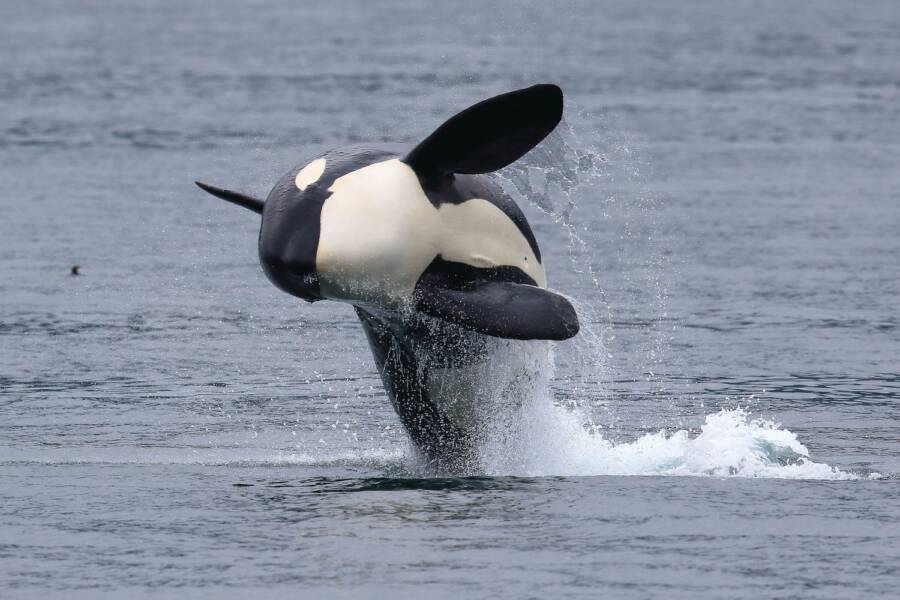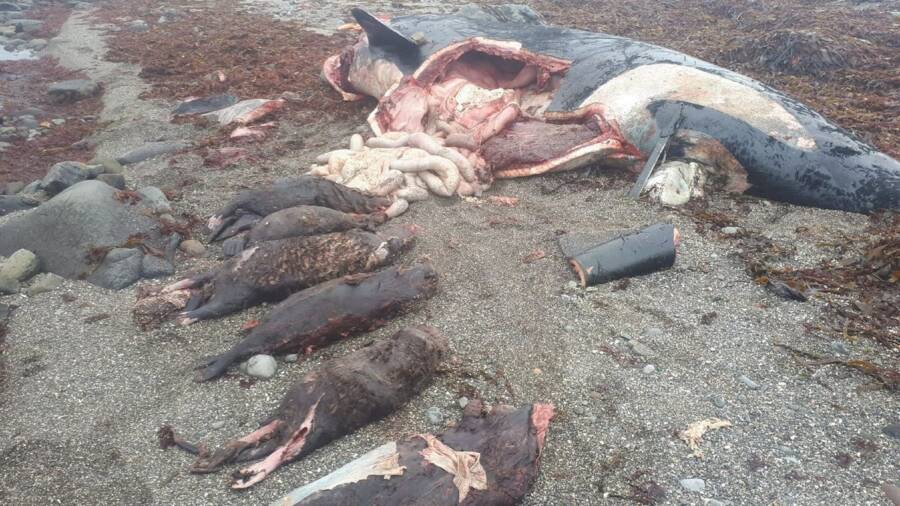The orca was part of a population known as Bigg’s killer whales, which may be responsible for the decline in the otter population between the Aleutian Islands and the Gulf of Alaska.

Bart Rulon / Puget Sound ExpressBigg’s killer whales are typically found in an area stretching from the Aleutian Islands and the Gulf of Alaska to the coast of California.
In a highly unusual case, an orca was found dead off the coast of the Russian Commander Islands in the Bering Sea — with six fully intact sea otters in her stomach.
Russian researchers found that the female orca had swallowed six sea otters whole, and had a seventh stuck in her throat between her oral cavity and esophagus. They published their findings in a new study in the journal Aquatic Mammals.
“The finding is very unusual,” said Dr. Olga Filatova, a researcher at Moscow State University and co-author of the study, in an interview with IFL Science. “Killer whales normally do not eat sea otters — there were some observations of them harassing and killing sea otters, but very few proofs of actual consumption.”
Sea otters are not usually part of an orca’s diet. Their diets can vary between different populations and ecosystems, but most commonly, orcas prey on seals, sea lions, salmon, squid, and other whales.
Researchers have offered multiple theories for this orca’s atypical eating behavior.
“I am not sure why this particular whale tried to swallow seven sea otters in a row — maybe it was very hungry, or sick, or crazy,” Filatova said.
“Their traditional diets may have dwindled, this individual was starving or it became savvy at picking out otters as easy prey from a coastal gulley,” said Dr. Alex Ford, a professor of biology at the University of Portsmouth in the U.K., in an interview with Newsweek.

Sergey V. FominAn orca carcass that washed up off the coast of the Russian Commander Islands was found to have six whole otters in her stomach, with a seventh stuck in her throat.
Another theory is that this orca picked up its eating habits from its original habitat, which is far from where it was found.
DNA analysis of the orca showed it was part of a population known as “Bigg’s killer whales,” which roam an area stretching from the Aleutian Islands and the Gulf of Alaska to the coast of California. According to the Georgia Strait Alliance, Bigg’s killer whales do not interbreed with any other kinds of orcas, leading to a variety of orca that has been genetically distinct for at least 750,000 years.
According to IFL Science, the otter population in the home region of the Bigg’s killer whales has been declining since 2008. Scientists thus far have not been able to determine why the otter population is dwindling, but researchers believe this find may indicate that this population of orcas preys on otters.
“It is not common, but killer whales have been known to eat sea otters and have even been suggested as having played a role in their decline in Alaska in the 1990s,” said Joseph K. Gaydos, a wildlife veterinarian and science director of the SeaDoc Society at the University of California, Davis, in an interview with Newsweek.
“This adult female may have been hunting alone or the otters may have been just small enough for her to swallow them whole,” Gaydos added. “All except the last, which it sounds like could have caused her demise.”
This is the first time an orca from the Bigg’s killer whale population has been found in the western Pacific, according to Live Science. The researchers said this suggests that this orca picked up her eating habits from her home region.
“Some orcas specialise on specific prey, and it turns out orcas are picky eaters! Once they’ve learned what their family eats, they aren’t likely to switch diets,” the Whale and Dolphin Conservation website states.
It is also highly unusual for an orca to swallow its prey whole. Filatova said orcas typically tear their prey into pieces and eat only the best, fattiest parts.
“Killer whales don’t really chew their food, but instead usually break up their prey before swallowing it by thrashing it or tearing between several animals,” Gaydos said.
The female orca was also found to have 256 cephalopod beak parts in her stomach, likely from octopuses or squid.
“Investigating the stomachs of stranded killer whales is crucial to directly confirm feeding on particular species,” the researchers wrote in their study, “because visual observations often leave uncertainty as to whether an attack was a predation or just harassment, and feeding on species like squid is impossible to observe.”
After reading about the baffling case of the orca that swallowed seven sea otters whole, read about the SeaWorld trainer killed by an orca. Or, read about the sea otter in Santa Cruz who attacked surfers and stole their surfboards.





